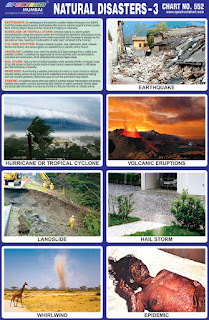 |
| Natural Disasters - 3 Chart |
Spectrum Chart - 552 : Natural Disasters - 3
1. Earthquake - An earthquake is shaking
caused by sudden movements of rocks in the Earth's crust. They can be
extremely violent. Earthquakes are usually quite brief, but may
repeat. Shaking and ground rupture are the main effects created by
earthquakes, principally resulting in more or less severe damage to
buildings and other rigid structures.
2. Hurricane or Tropical Cyclone - A
hurricane is a circular air movement over the warm ocean waters in
the warm part of Earth near the equator. Most hurricanes create
strong winds and heavy rains. While some hurricanes stay out in the
sea, others pass over land. This can be dangerous because they can
cause a lot of damage. When hurricanes reach land, they may break
things. Sometimes they kill people and destroy cities.
3. Volcanic Eruptions - A volcano is a
rupture in the crust of a planetary-mass object, such as Earth, that
allows hot lava, volcanic ash and gases to escape from a magma
chamber below the surface. Earth's volcanoes occur because its crust
is broken into 17 major, rigid tectonic plates that float on a
hotter, softer layer in its mantle. Therefore, on Earth, volcanoes
are generally found where tectonic plates are diverging or
converging.
4. Landslide - A landslide, also known as
a landslip, is a form of mass wasting that includes a wide range of
ground movements, such as rockfalls, deep failure of slopes and
shallow debris flows. Landslides can occur in underwater, called a
submarine landslide. Landslides occur when the stability of the slope
changes from a stable to an unstable condition. A change in the
stability of a slope can be caused by a number of factors, acting
together or alone.
5. Hail Storm - Hail is a form of solid
precipitation. It consists of balls or irregular lumps of ice, each
of which is called a hailstone. Sleet falls generally in cold weather
while hail growth is greatly inhibited during cold surface
temperatures. There are methods available to detect hail-producing
thunderstorms using weather satellites and weather radar imagery.
Severe weather warnings are issued for hail when the stones reach a
damaging size, as it can cause serious damage to human-made
structures and most commonly, farmers' crops.
6. Whirlwind – A whirlwind is a weather
phenomenon in which a vortex of wind (a vertically oriented rotating
column of air) forms due to instabilities and turbulence created by
heating and flow (current) gradients. Whirlwinds occur all over the
world and in any season. Major whirlwinds last longer because they
are formed from very powerful winds and it is hard, though not
impossible, to interrupt them. Minor whirlwinds are not as
long-lived; the winds that form them do not last long, and when a
minor whirlwind encounters an obstruction, its rotation is
interrupted.
7. Epidemic – An epidemic is the rapid
spread of infectious disease to a large number of people in a given
population within a short period of time, usually two weeks or less.
An epidemic may be restricted to one location; however, if it spreads
to other countries or continents and affects a substantial number of
people, it may be termed a pandemic. The declaration of an epidemic
usually requires a good understanding of a baseline rate of
incidence, epidemics for certain diseases, such as influenza, are
defined as reaching some defined increase in incidence above this
baseline.

No comments:
Post a Comment